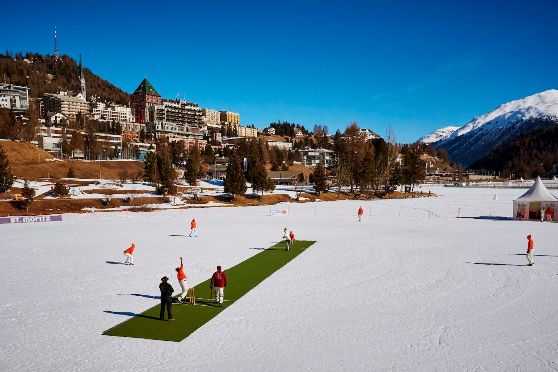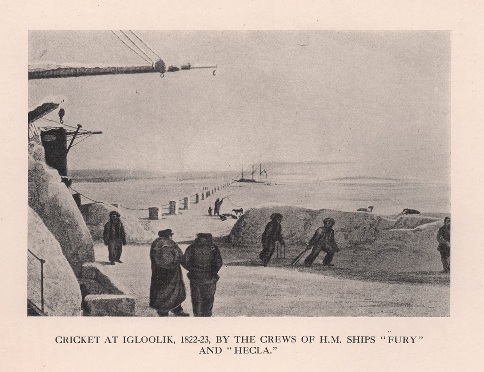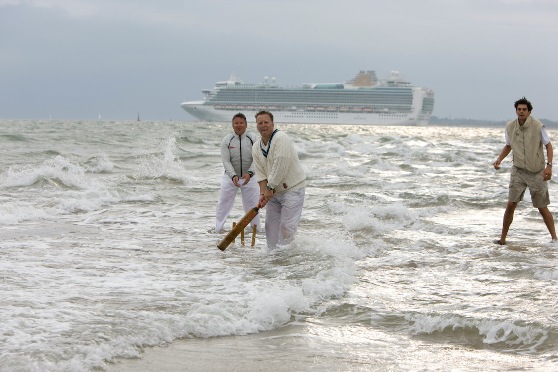Nowhere is off limits for the game of Cricket
By Deepti Unni
On land, in the sea, on ice, on a volcano, on a mountain – never mind the terrain, if there’s enough room to swing a cat, there’s probably a cricket match on.
Damp pitch? Wet outfield? Bad light? Phooey, say the members of the Island Sailing Club and the Royal Southern Yacht Club, who gather to play their annual match on the Brambles sand bank. Once a year the tide in the Solent Strait, between Southampton and the Isle of Wight, recedes enough to expose about 180 metres of sandbar, and the members descend in a flotilla to play a frenzied game for the hour the sand bank remains above water. There are few rules – including that the players must wear whites, and that each team takes turns ‘winning’ every year. The match was first started by pioneering boat builder Uffa Fox in the late 1950s and has been held annually since, though some years the tide doesn’t recede far enough, as in 2008, in the photo above – but it did nothing to dampen enthusiasm for the game.
Not a beach person? Well, the hills are also alive with the sound of leather on willow. The “most prestigious event in the Swiss cricketing calendar” takes place off-piste, on frozen lake St Moritz in February every year. The event was kickstarted in 1988, supposedly when a group of English tourists landed up at the ski resort to find no snow. Daniel Haering, who was part of the group, rounded up some students and equipment from his former school, Lyceum Alpinum down in the valley, and got a cricket match going instead. The event has seen a fair bit of star power – the most retold story is that of David Gower who parked his car on the ice before the match one year and returned to find a big hole and no car. In 2018, two 20-over exhibition matches were held here, featuring the likes of Andrew Symonds, Mahela Jayawardene, Virender Sehwag, Shoaib Akhtar and Graeme Smith.

Sub-zero temperatures have never been a deterrent to cricket. In 1822-23, explorer William Edward Parry was tasked with finding the fabled Northwest Passage through the Arctic, with his ship HMS Fury, and HMS Hecla, commanded by George Francis Lyon. At one point, the two ships found themselves icebound, with no escape until the ice melted the following year, in summer 1823. The crews overwintered at Igloolik, an Inuit settlement in Nunavut, northern Canada, and passed the hours playing cricket in -23° to -35°C weather, as sketched by Lyon himself.

Everest Base Camp has been the venue for many a cricket match. In 2007, 18 British cricketers attempted to set a record for the world’s highest-altitude cricket match, playing a six-a-side, five-over game. In 2009, a full 20-over match, complete with groundsmen and medics, was staged at the Gorak Shep glacier, at a height of 5165 metres, the record until it was broken in 2014 by two teams that trekked to the summit of Kilimanjaro. The Gorillas team, led by Heather Knight, made 82 for 5 against the Rhinos, captained by Ashley Giles (and featuring Makhaya Ntini) who managed only 64 for 9 before cloud stopped play. The match was played at 5752 metres above mean sea level.

How many cricket tragics does it take to start a club? Just one will do if you’re Aliya Bauer. In Kenya for a research project on baboons, Bauer found she was missing cricket too much. She began teaching the local boys with borrowed equipment but it piqued the curiosity of the local Maasai tribe, who were keen to have a go at it themselves. They did and it stuck, and the Maasai Warriors have since played against local clubs and travelled to England to play club sides as well. The warriors are now using their games to bring attention to issues like gender inequality, female genital mutilation and HIV.

The world’s first subterranean cricket match was played in 2013, in the Honister Slate Mine in the Lake District, UK. On a pitch 600 metres under the surface, with slate tiles for bails, the Caldbeck and Threlkeld cricket clubs played a Christmas fixture to raise money for the latter’s flood-damaged ground. Next time rain ruins another cricket match in the UK, this might just be the next best alternative.

Cricket on ships is practically de riguer – better yet if it’s an aircraft carrier. What else is all that deck space for? Deep extra cover might need a boat, though.

-Deepti Unni is an assistant editor at ESPNcricinfo and this article was originally featured on thecricketmonthly.com


